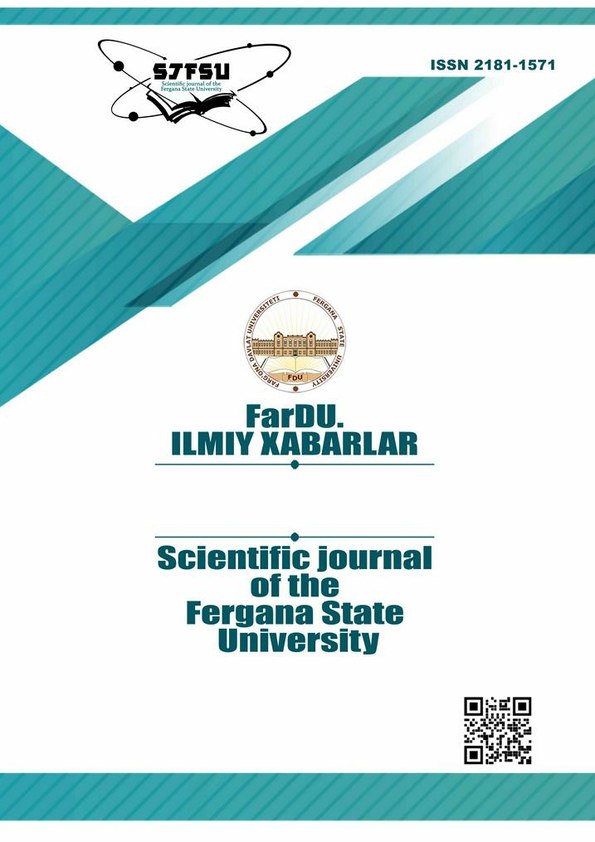ABOUT NAME NEOLOGISM
Main Article Content
Abstract
The article is devoted to the descriptive interpretation of the names of neologisms of the period of independence. On the example of ergonyms, the role of borrowings of the source language in the formation of names and promising ways of choosing a national name is studied. In the process of analysis, the names of trading places were considered as a separate system. Specific examples illustrate the essence of the name, important aspects of its formation as a sphere. It was also explained that new naming models in world practice are becoming the task of representatives of such areas as a linguist, marketer, psychologist and lawyer. Analyzed and commented on the opinions of linguists who conducted research on the topic of names. The reflection coefficient of neologism names in cross-sectoral studies was studied, and it was recognized that this criterion is determined by the ability of networks to perceive innovations. The requirements for the proper place of the name in the vocabulary are determined. It is proved that the created name can convey important information about the object or product that it names, fully meets the phonetic, lexical, morphological norms of the language.
Article Details

This work is licensed under a Creative Commons Attribution-NonCommercial-NoDerivatives 4.0 International License.
References
Lutfullayeva D., Saparniyazova M. Neyming: tilda nom yaratish texnologiyasi. //O‘zbekistonda xorijiy tillar. – 2020. – № 6. – бет 11. (Lutfullayeva D., Saparniyazova M. Neyming The technology of creating a name in a language Foreign languages in Uzbekistan)
Кожанова В.Ю. Лингвистические основы наименований брендов (на примере английского и русского языков): Автореф. дисс. ... канд. филол. наук. – Краснодар, 2007. – -С. 20 (Kojanova V.Y. Linguistic bases of brand names in the first English and Russian languages)
Подольская Н.В. Словарь русской ономастической терминологии. – М.: Наука, 1978. – С. 166 (Podolskaya N.V. Dictionary of Russian onomastic terminology)
Begmatov E. O‘zbek tili antroponimikasi. – Toshkent: Fan, 2013. – bet 37. (Begmatov E. Anthroponymy of the Uzbek language)
Конишевский Д. В., Кушнарева Н. В., Ветров С. А. Неологизмы цифровой культуры (активный словарь миллениала). – ООО ДиректМедиа, 2019. – С. 6 (Konishevsky D.V., Kushnareva N. V., Vetrov S.A. Neologisms of digital culture (an active dictionary of the millennial)
Ro‘zimboyev S., Yangibayeva S. Ergonimlarning ma’no qirralari. Ilm sarchashmalari. 2017. 11-son. – bet 93. (Ruzimboev S., Yangibaeva S. Semantic aspects of ergonims. Sources of knowledge. 2017. No. 11. – P. 93)
Begmatov E. O‘zbek tili antroponimikasi. – Toshkent: Fan, 2013. –bet 37. (Begmatov E. Anthroponymy of the Uzbek language)
Овсянникова К.В. Особенности номинации предприятий общественного питания (на примере коммерческих названий г. Воронежа и г. Москвы): дисс. … канд. филол. наук. Воронеж, 2016. – С. 191 (Ovsyannikova K.V. Features of the nomination of public catering enterprises (on the example of commercial names of the city of Voronezh and Moscow)
McDonald L. The meaning of “e-”: Neologisms as Markers of Culture and Technology //eTopia. – 2005
Конишевский Д. В., Кушнарева Н. В., Ветров С. А. Неологизмы цифровой культуры (активный словарь миллениала). – ООО ДиректМедиа, 2019. – С. 7 (Konishevsky D.V., Kushnareva N.V., Vetrov S.A. Neologisms of digital culture (an active dictionary of the millennial)
ОНОМАСТИКА // Большая российская энциклопедия. Том 24. – Москва, 2014. – С. 212 (ONOMASTICS // Great Russian Encyclopedia)
Lutfullayeva D., Saparniyazova M. O‘zbek tilida nom yaratishda antroponimlardan foydalanish amaliyoti // “Tilshunoslikdagi zamonaviy yo‘nalishlar: muammo va yechimlar” mavzusidagi xalqaro ilmiy-amaliy onlayn konferensiya materiallari. – Andijon, 2020. – bet 197. (Lutfullayeva D., Saparniyazova M. The practice of using anthroponyms in the creation of names in the Uzbek language Proceedings of the international scientific-practical online conference “Modern trends in linguistics: problems and solutions)

